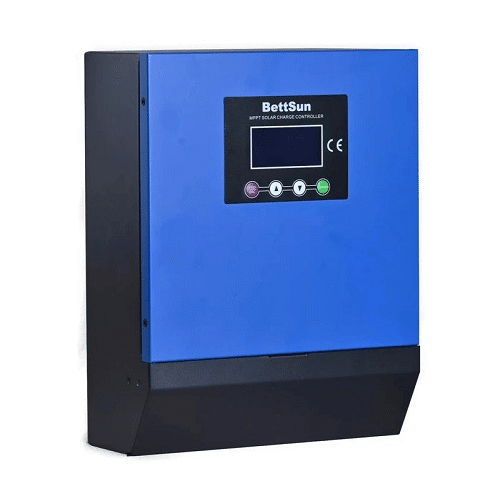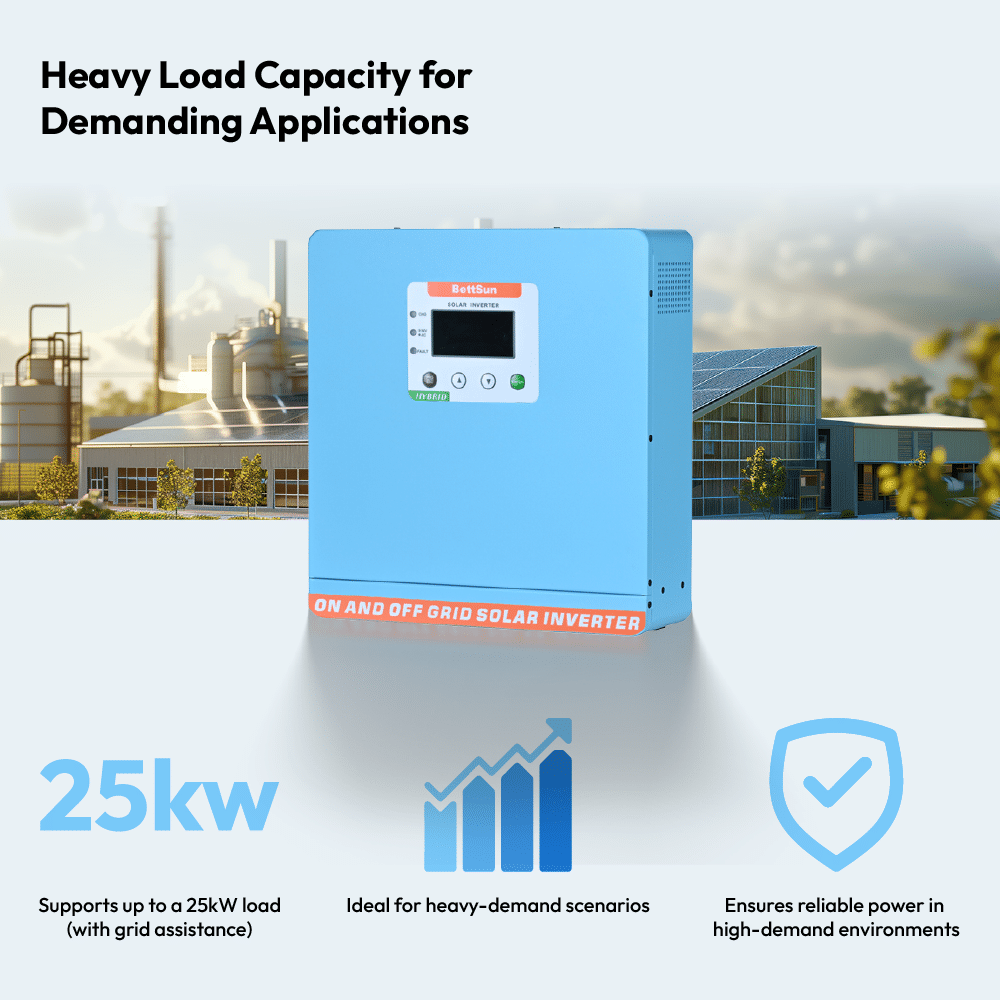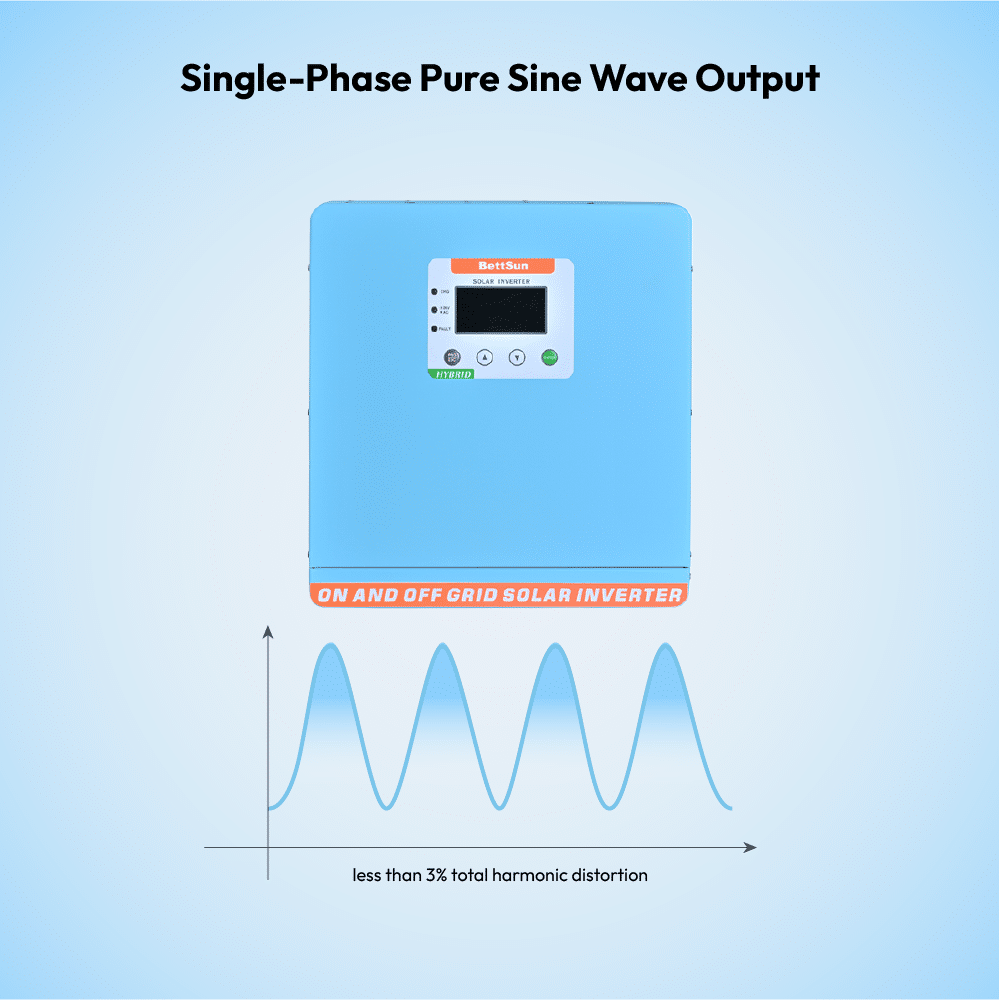You just heard about hybrid solar inverters and wonder, “Do I have to buy pricey batteries on day one?” The quick question in your head is simple: Can a hybrid solar inverter work without batteries and still power my lights? Good news—I’ve got answers for you in kid-simple language. Yes, most hybrid solar inverters run fine with no batteries. They
- Act like regular grid-tie inverters.
- Send extra solar power straight to the utility.
- Switch later if you add storage.
- Keep their smart tracking and safety tools.
- Let you start small and grow later.
In this guide, we’ll walk through how the machine works, what you gain, what you lose without storage, cost math, safety tips, and future trends. By the end, you’ll know when a hybrid solar inverter alone is perfect and when a battery pack turns it into a superhero.
How A Hybrid Solar Inverter Works
A hybrid solar inverter is like a three-way translator. It speaks panel DC, house AC, and battery DC. Even with no battery, it still flips sunshine into the AC wave your fridge loves. Think of it as a smart traffic cop: it measures sunlight, grid needs, and home load, then sends power to the right lane—all in milliseconds.
DC To AC In Grid-Tie Mode
Panels make direct current (DC). The hybrid brain chops, boosts, and smooths that DC into alternating current (AC) that lines up with the grid wave. No battery required.
Charge Controller Built Inside
The same box hides a charger ready for lithium packs. When no battery is hooked up, this part naps. Plug a battery in later, and it wakes up to manage volts and amps safely.
Auto Switch During Outage
Add storage and the inverter flips to “island” mode in under 20 ms, keeping lights on. Without storage, it simply shuts down during grid loss like any grid-tie unit.
Running Without Batteries: Grid-Tie Mode Explained
A hybrid solar inverter in grid-tie mode watches household demand first. If your TV needs 200 W and panels make 500 W, 200 W feeds the TV, while 300 W flows to the utility meter, spinning it backward. When clouds roll in, the grid tops you up. No battery means no middleman—power goes panel-to-house-to-grid in one hop, making the system super efficient on sunny days.
Info: Many utilities pay credits for each surplus kilowatt-hour you export, a perk called net metering.
Benefits Of Battery-Free Operation
Choosing no battery cuts start-up cost by 30-50 %. You skip heavy racks, vents, and fire-code extras. Fewer gears means easier permits and a smaller wall footprint. A battery-free hybrid solar inverter also runs cooler because it isn’t charging cells at night, boosting life span.
Quick Tip: Use the inverter’s app to cap export power if your utility limits back-feed.
Limits Of Skipping Batteries
No battery, no backup. A blackout still means dark rooms because the inverter must shut off to protect line workers. You also miss time-of-use savings—charging cheap, discharging costly. Finally, you rely on the grid at night, so full energy independence stays a dream until you add storage.
Danger: Never assume panels alone keep lights on during outages; verify your setup.
Adding Batteries Later Made Easy
Most brands design plug-and-play ports. Snap in a lithium pack, run the included communication wire, update firmware, and the hybrid solar inverter auto-detects the new friend. Typical add-on time: under two hours for a pro crew. You gain night power, blackout backup, and deeper self-consumption.
Assumes 1.2 kW evening load
Success: Start grid-tie today, bolt batteries tomorrow—your earlier investment stays safe.
Choosing The Right Hybrid Solar Inverter Size
Match inverter AC rating (kW) to your panel array and future battery dreams. A 5 kW hybrid inverter pairs well with 6 kW of panels and up to 10 kWh storage. Oversize panels by 20 % to hit max output on cloudy days. Check that DC input volts fit your string layout and that battery amps match future packs.
Fact: Many hybrid units accept 150 % DC oversizing—read the datasheet fine print.
Monitoring And Smart Apps Matter
Live data turns sunlight into fun. Good apps show watts now, today’s kilowatt-hours, and lifetime CO₂ saved. They push alerts if a string dips, letting you clean bird droppings fast. A battery-ready dashboard also shows future charge/discharge plans once storage joins the party.
Suggestion: Pick a hybrid solar inverter company that offers free lifetime cloud logging, not a yearly fee.
Cost Breakdown: With Vs. Without Batteries
| Item | Grid-Tie Only | With 10 kWh Battery |
| Panels 6 kW | $6 000 | $6 000 |
| Hybrid inverter | $1 800 | $1 800 |
| Mount, wiring | $1 200 | $1 200 |
| Batteries | — | $5 500 |
| Labor & permits | $2 000 | $2 500 |
| Total | $11 000 | $17 000 |
Battery-free starts cheaper and often pays back in 5–7 years via energy credits. Battery add-on may stretch payback to 9–12 years but grants security and higher self-use.
Safety And Installation Tips
Mount the hybrid solar inverter on a cool, shaded wall. Leave 30 cm clearance for airflow. Keep DC switches reachable and label them clearly. Hire licensed electricians who follow NEC or local codes. If planning batteries later, stub in conduit and reserve wall space now.
Warnings: DIY high-voltage work can be lethal—never skip permits or inspections.
Future Trends In Hybrid Inverters
Expect bigger MPPT ranges, built-in EV charger ports, and AI-driven power shifting. Some brands test micro-grid sharing, letting neighbors trade surplus. A leading hybrid solar inverter company already pilots units that talk to heat pumps and water heaters, timing chores for maximum sunshine.
Conclusion
A hybrid solar inverter can absolutely run without batteries, acting just like a grid-tie unit while keeping doors open for future storage. Starting simple slashes cost, speeds permits, and still slashes bills. Add batteries later to unlock backup power and greater independence. Either way, the hybrid path gives you the freedom to grow at your own pace—sunlight today, storage tomorrow, savings forever.
FAQs
will the inverter waste power with no batteries?
No, it sends all extra energy to the grid or throttles panels if exports are capped.
can I add any battery brand later?
Stick to models listed by your inverter maker to keep warranty and safety.
does running battery-free shorten inverter life?
No, in fact less heat may extend lifespan.
how fast can batteries attach?
Pros often finish add-on installs in one afternoon.
what about blackouts without storage?
The inverter must shut off for line-worker safety; only battery mode supplies backup.






